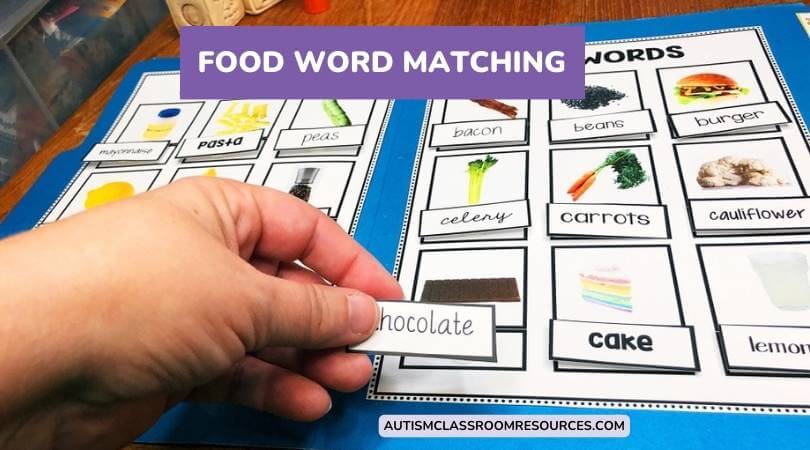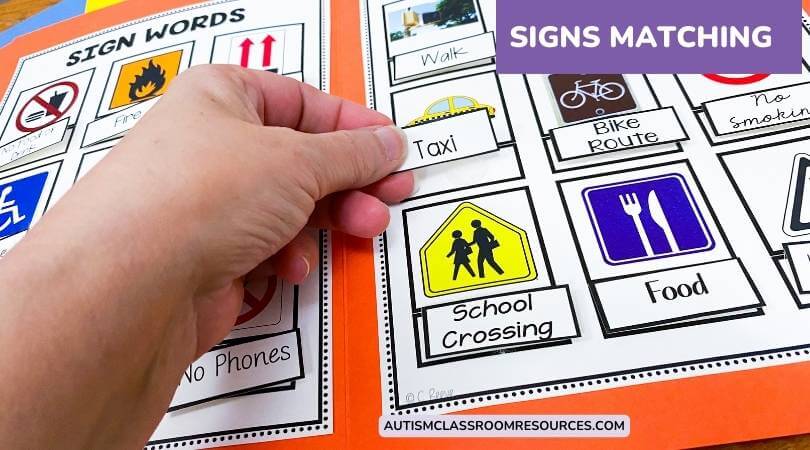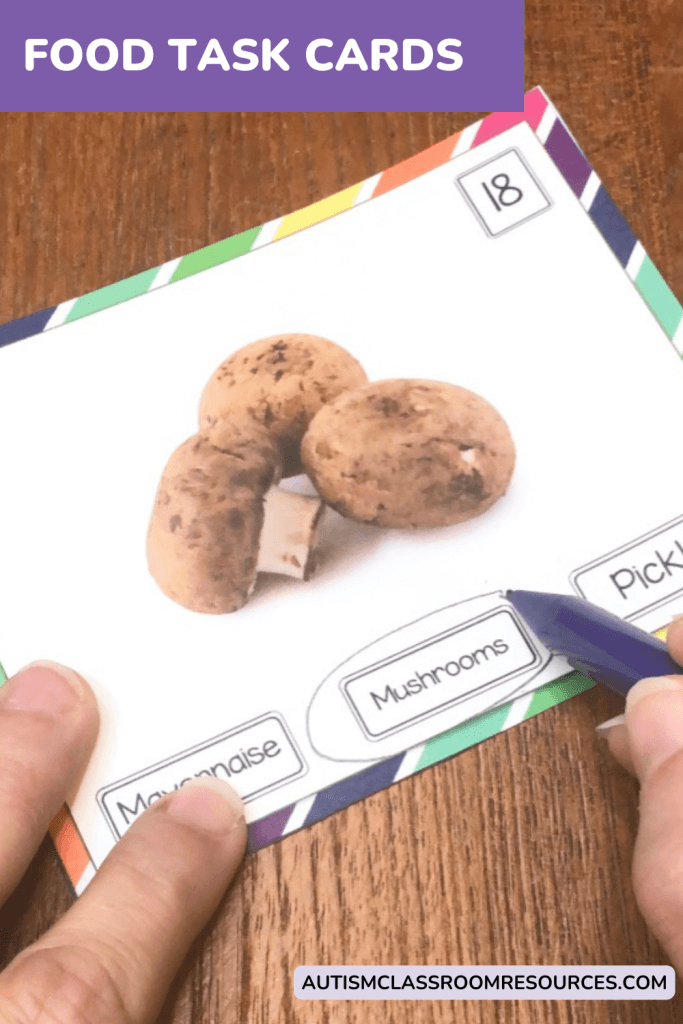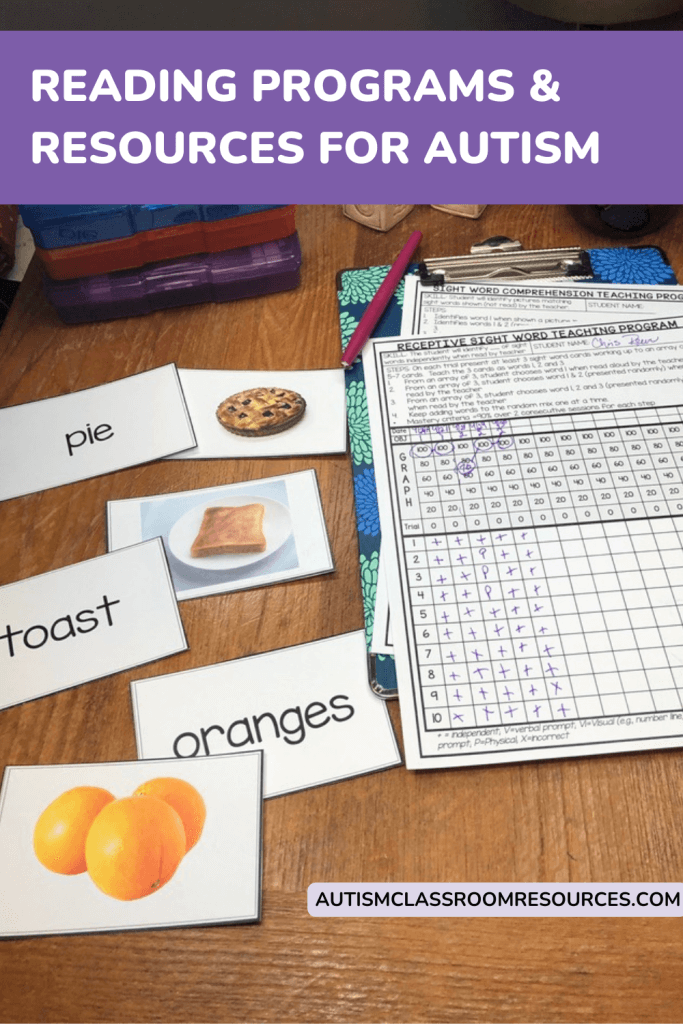I frequently get asked what are good reading programs for autism or how to teach reading to students with autism spectrum disorder. I did a post a while back on the challenges and thoughts about teaching reading to students with autism, and many of you asked for ideas about tools to support reading in your classrooms.
This post will help gather some current tools for improving reading skills specifically for students with autism. But these resources are also great (and frequently were developed) for students in special education in general.

This is not a comprehensive review of all the curricula or materials available. In my earlier post I talked about the fact that there isn’t an “autism spectrum reading curriculum.” Reading curricula are developed to address skill deficits specific to reading. But students with ASD have significant difficulty with language, which makes reading skills and particularly reading comprehension difficult for many of them.
Information About Reading Programs for Autism
I talked in my earlier post about using Edmark, PCI and Reading Mastery. They are some of the best tools I’ve found for teaching reading. But, like many curricula, they often benefit from additional materials. Students with autism, in particular, need specific instruction in comprehension skills. Here are some posts and websites with information about each of them and other curricula.
PCI Reading
There are very few reviews out there about PCI but I have worked with several districts that have used it and loved it. Superteach, my sister, used it in her classroom and has written one of the few reviews I could find:
Edmark Reading Curriculum
Many of us have used Edmark as one of the oldest, most established sight word programs we had available until PCI came along. There are 2 versions of Edmark: Level 1 and 2 and the Functional Word Series.

Edmark Level 1 and 2
It is available in a print and and in an online reading program. The words in the program parallel the Dolch word list. There are some comprehension activities available, but one of the biggest disadvantages to the Level 1 and 2 is that they have limited comprehension activities. And the ones they do have are a little esoteric to me (put the egg in the car where the egg is bigger than the car doesn’t work for me).  I have some comprehension tools listed below.
I have some comprehension tools listed below.
See the Superteach review of Edmark or PCI noted above for an overview of their similarities and differences.
This series of videos shows what the Edmark Level 1 looks like and how it can be used. (I do not know why the series seems to begin with Part 2, I couldn’t find part 1).
Edmark Functional Word Series
I love the functional word series because it focuses on real-life words that the students can use immediately. I remember being in a classroom many moons ago with a teacher who was trying to use an esoteric reading curriculum with her middle school student with autism.
She wanted to teach him the word “the.” I used the functional word series to teach him to read “hamburger” and then find it on a menu. Guess which one was more motivating to him.
Because our students always benefit from more work in comprehension than most curricula provide, this is an area that needs supplementing. But the Edmark series does provide some worksheets for generalization of the skills. It focuses on restaurant-fast food words, grocery words, job-work words and community signs. I use this curriculum frequently for secondary students.
Reading Mastery
One of the myths I busted in the previous article is that students with autism should only learn sight words. Research shows us that if we teach phonics, students reading can expand exponentially. And we don’t have to limit ourselves to just phonics-based reading OR sight words. We can teach both. For students who are working on phonics-approaches, the SRA Reading Mastery program is an excellent tool that I talked more about in my earlier post.
The Association for Direct Instruction has a video channel with this video introducing Reading Mastery. The channel has more information and demonstration of how the different parts of used. This isn’t specific to autism and is typically conducted in a group.
When I have worked with Reading Mastery with many teachers, we usually did the instruction for students with ASD 1-1 or 1-2 so it could move at the pace for that student. However, there are some students who could use it in the group format and the process of using it is the same. More videos about Reading Mastery are also available on the McGraw-Hill YouTube channel on Direct Instruction.
Teaching Literacy
Teaching literacy is a broader way of looking at teaching reading. Reading is, of course, much more than just reading what’s on a page. It’s about being able to use reading as a skill in everyday life. Here are some initial tools for literacy that you might find helpful.
Paula Kluth has probably the most extensive resource of literacy through her books. This post sums up her suggestions for addressing literacy with students with on the autism spectrum.
Adventures in the ATC did a great blog post about The Oelwein & Broun method of teaching literacy that is worth reading in terms of teaching students with autism specifically.
The Stellar Teacher was a guest on the podcast and has some good and easy-to-implement tips for fostering this skill for students with autism.
Reading Programs for Autism: Sight Words Skills
Superteach56’s TPT Storehas a variety of tools to accompany reading curricula to give students with autism and other disabilities more practice. They provide practice building vocabulary as well as addressing sight word reading. Click on her name for a few related freebies as well.
Sight Word Worksheets Level 1
Sight Word Worksheets Level 2
Sight Word REVIEW Worksheets Level 1
Sight Word REVIEW Worksheets Level 2
Roll Read and Color Sight Words
Reading Functional Sight Words Curriculum Bundle–Food Words
This bundle was designed specifically to a set of tools to teach 100 common food word sight words. It includes both an instruction kit that works on reading skills, reading comprehension, and fluency of reading the words. There is a video demonstrating the instruction components. And there are interactive books to practice reading the vocabulary in print, as well as file folders for matching words to pictures, worksheets, task cards, and a bingo game as well. It is designed to give you what you need to clearly teach reading skills for the targeted food words seen in environmental print.
Teaching Sight Words for Common Community Signs
To supplement instruction on common environmental signs, I’ve created similar materials to the bundle described above. They are specifically designed to work on matching the written words to pictures. You can find
- Community Signs Sight Word BINGO,
- Community Signs Functional Literacy Task Cards,
- Community Signs Worksheets, and
- File Folders and Activities for Safety and Community Signs
Reading Comprehension Tools
I wrote a post on functional reading skills that included some IEP goal / objective examples that can be helpful using some of my functional reading products.
Because autism affects language, reading comprehension is such a critical area for these students. And most general curricula don’t spend significant time teaching reading comprehension. This is particularly true for older students in life skill classrooms working on sight words for functional skills.
Why Books are So Important for Reading Instruction
Typically, in general reading curricula, students read books with the vocabulary they are learning. But those are hard to find for older students that are written at their reading level, but also have older topics, characters, and images.
I’ve created several resources that specifically include common, daily vocabulary into interactive books that are written on approximately the second grade level, focused on daily living and community activities. One of the most common pieces of feedback I get from teachers on these books is how happy the students are to be able to read a book. That in itself speaks volumes to me about the importance of having books that fit their age and their reading skills.
Life Skills and Reading Comprehension
For instance, I have Life Skills reading activities that focus specifically on reading skills and vocabulary related to common activities of daily living. And they are specifically designed to work on reading comprehension.
There is a print and digital bundle for teaching reading and vocabulary about doing laundry. The 5-book set comes with
- a teaching program for comprehension,
- reading comprehension task cards with and without picture choices,
- sequencing strips and templates for 4 of the books for students to order steps reviewed in the book,
- lesson plans for using the books as part of whole group and explicit instruction, and
- potential IEP goals for AAC use in reading
Check out the laundry books books here.
I also have a similar set of books for chores around the house. These are 4 books with photos of teens and adults completing common chores inside and out of the house. They have the same comprehension supprts as the laundry set. Find the At Home Reading Series here.
And finally, there are some general reading activities for environmental print and comprehension The following are some comprehension resources that are not aligned with curricula that you might be interested in. I have a variety of functional literacy activities that involve reading grocery store flyers and ads, sales ads for department stores, and my adaptive interactive books.



The post Resources & Effective Reading Programs for Autism Spectrum Disorder appeared first on Autism Classroom Resources.
This content was originally published here.
